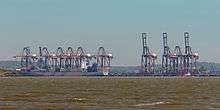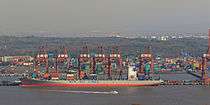Jawaharlal Nehru Port
| Nhava Sheva न्हावा शेवा | |
|---|---|
|
A container ship at Nhava Sheva | |
| Location | |
| Country | India |
| Coordinates | 18°57′N 72°57′E / 18.950°N 72.950°E[1] |
| Details | |
| Operated by | Jawaharlal Nehru Port Trust |
| Owned by | Government of India |
| Statistics | |
| Annual cargo tonnage |
Bulk: 7.88 million tons (2010-11)[2] Container: 56.43 million tons (2010-11) |
| Annual container volume | 4.47 million TEU (2014-15)[3] |
|
Website jnport | |
Jawaharlal Nehru Port, also known as Nhava Sheva, is the largest container port in India.[4][3] Located east of Mumbai in Maharashtra, the port on the Arabian Sea is accessed via Thane Creek. Its common name derives from the names of Nhava and Sheva villages that were situated here. This port is also the terminal of Western Dedicated Freight Corridor proposed by Indian Railways.
History
Ever since its inception on May 26, 1989, Jawaharlal Nehru Port (JNP) has blazed a new path for itself in the port sector – aiming to set the benchmark for the heights India could reach in technological innovation and administrative skill. Envisioned in a remote location about 10 km across the Bombay Harbour, JN Port rose up from paddy fields, salt-pans and marshlands, in a Herculean effort at construction – the first large-scale industrial development in independent India. The Port is as much a representation of what is best about India's capabilities, from project conceptualization to completion, as it is an example of human endeavor against all odds.
It has charted India’s international trade to a glorious course of success and achievements, breaking records and creating new benchmarks. JN Port is the biggest container handling port in India, handling around 44% of the country’s containerized cargo, crossing the historic landmark of 4 million TEUs in container throughput consecutively for the last five years. In its coveted role as the Hub Port on the West Coast of India, JNP is ranked 31st among the top 100 Container Ports in the world.
Having set for itself a long-term goal of achieving 10 million TEUs by the year 2020-21, through addition of two more Terminals, viz. the 330M Stand-alone Container Terminals (DP World) and the 4th Container Terminal (Port of Singapore Authority) and a Satellite Port at Vadhvan Point, JNP throws open an array of worthwhile opportunities for the maritime trade, including the shipping lines and shippers, to ferry their cargo to various sectors across the globe.
Supported by a top of the order, world-class infrastructure with high technological standards, facilities at JNP consist of a full-fledged Custom House, 30 Container Freight Stations and connectivity to 52 Inland Container Depots across the country. The excellent hinterland connectivity both by rail and road is being further strengthened by ongoing projects like the Dedicated Freight Corridor (DFC), which will increase the existing train capacity of 27 to 100 trains per day; Multi-Modal Logistics Park (MMLP) and widening of the Port road connectivity. lts proximity to the Cities of Mumbai, Navi Mumbai and Pune; airports; hotels, exhibition centres, etc. gives the Port an extra edge to address the shippers’ needs, efficiently and promptly.
With a strong commitment to provide seamless service to the customers as India’s prime facilitator of international trade and logistics, Jawaharlal Nehru Port strives to be the undisputed leader in the South Asia Region in the years to come.
Facilities
The JNPT Container Terminal is operated by JNPT. It has a quay length of 680 metres (2,230 ft) with 3 berths.[5]
The Nhava Sheva International Container Terminal (NSICT) is leased to a consortium led by P & O, now a part of DP World. Commissioned in July 2000, it has a 600 metres (2,000 ft) quay length with two berths. It can handle up to 15.6 million tons of cargo.[6] NSICT was India’s first privately managed container terminal. In the year 2006, GTI (Gateway Terminals India Pvt Ltd), a third container terminal operated by APM Terminals, with the capacity to handle 1.3 Million TEUs was commissioned. A new standalone container terminal by the name of NSIGT having a quay length of 330 m and a capacity of 12.5 Million Tonnes will be fully operational by July, 2016. Work has commenced for commissioning of fourth container terminal with a quay length of 2,000 m. This terminal will be operated by PSA and will have a capacity of 4.8 Million TEUs (60 MTPA). Phase-I of the project with a quay length of 1 km will be commissioned by Dec., 2017.
Jawaharlal Nehru Port has become the first port in the country to implement logistics data tagging of containers. The port implemented the logistics data bank tagging of containers, first of its kind facility, which will help importers and exporters track their goods in transit through logistics data bank service.
An RFID (Radio Frequency Identification Tag) tag would be attached to each container which would be tracked through RIFD readers installed at different locations.
Traffic

JNP accounts for more than half of total container volumes handled at India's 12 public ports and around 40 percent of the nation's overall containerized ocean trade.[3] Major exports from Jawaharlal Nehru Port are textiles, sporting goods, carpets, textile machinery, boneless meat, chemicals and pharmaceuticals. The main imports are chemicals, machinery, plastics, electrical machinery, vegetable oils and aluminium and other non-ferrous metals. The port handles cargo traffic mostly originating from or destined for Maharashtra, Madhya Pradesh, Gujarat, Karnataka, as well as most of North India.
See also
References
- ↑ "Geographic Location". Jawaharlal Nehru Port Trust. Retrieved 2011-09-23.
- ↑ "Cummulative Traffic April 2010 to March 2011" (PDF). Jawaharlal Nehru Port Trust. Retrieved 2011-09-23.
- 1 2 3 "India's major ports see 6.7 percent growth in container volumes". JOC.com. 7 April 2015. Retrieved 27 June 2015.
- ↑ "The biggest ports of India". Rediff Business. Rediff.com. 8 October 2010. Retrieved 29 July 2013.
- ↑ "JNPT Container Terminal". Jawaharlal Nehru Port Trust. Retrieved 2011-09-23.
- ↑ "NSICT Private Terminal". Jawaharlal Nehru Port Trust. Retrieved 2011-09-23.
External links
- JNPT Nhavasheva Import Data
- JNPT Nhavasheva Port Import Data
- JNPT Nhavasheva Port Export Data
- Laudable Achievements of JNPT
- India - Nhava Sheva
- JNPT Nhavasheva Export Data
- JNPT growth plan, interview with Chairman JNPT. April 2014

